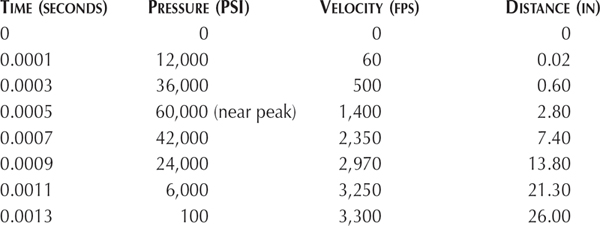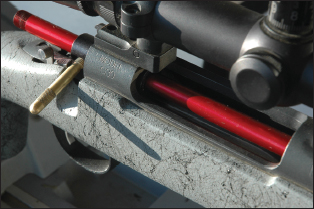When a primer ignites the powder charge, gases form, creating pressure inside the case. This pressure, which produces heat, accelerates the burn. On a graph, you will notice a steep pressure peak followed by a gradual decline as the bullet moves forward and the volume behind it increases. This pressure/time curve is essential in understanding bullet velocity.
Pressure and Bullet Velocity
A 180-grain bullet from a .300 Weatherby Magnum exits the muzzle of a 26-inch barrel about 1 ¼ milliseconds after ignition. The pressure peak occurs when the bullet has moved only about 3 inches, even with slow-burning fuels designed for a .300 Magnum.

The pressure drops rapidly, losing 90% of its force within the next 18 inches of the barrel. However, the bullet continues to accelerate as the pressure behind it diminishes. By the time it reaches the muzzle, the bullet is still accelerating, which highlights the advantage of a long barrel.
Pressure/Distant Curves in Rifles
Pressure/distance curves are important for designing gas-operated autoloading rifles, which rely on the pressure to cycle the mechanism. The chart below illustrates how pressure changes with the distance the bullet travels.

Note: A bore guide can help prevent chamber or throat wear during cleaning.
Measuring Pressure: The Crusher System
Pressure measurement has been an ongoing challenge, but in the mid-1800s, Alfred Nobel and Rodman developed solutions. The crusher system is still used today. This method involves a small cylindrical piston and a copper or lead pellet, which helps measure the pressure in firearms. However, this method can be inaccurate for peak pressure due to the slow flow of the copper or lead.
Modern Methods of Pressure Measurement
- Piezoelectric Gauges: These transducers deliver an electric charge when a crystal is crushed, providing a proportional reading in pounds per square inch (PSI).
- Strain Gauges: These are wires glued to the chamber wall. They stretch as the chamber expands, providing a measure of pressure.

Tip: Glass-bedding the action and floating a heavy barrel can improve accuracy.
Conclusion: Understanding Firearm Pressure and Bullet Performance
Pressure measurement is essential for firearm design and ammunition testing. Modern methods like strain gauges and piezoelectric sensors provide more accurate data, making it possible to fine-tune firearms for optimal performance.